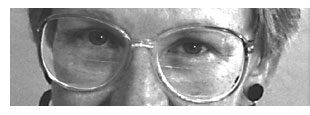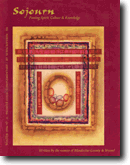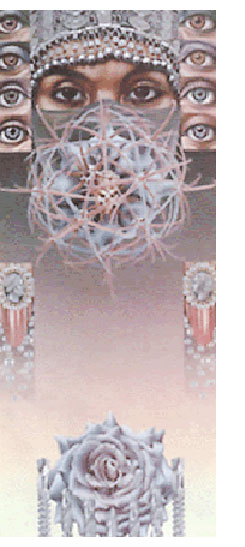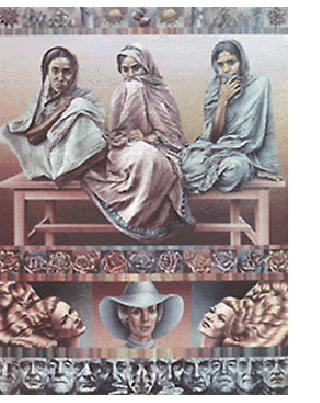SOJOURN MAGAZINE
PREMIER ISSUE
Winter 1996-1997
|
 I'm
fascinated by imagery. We've got a whole encyclopedia of images stored inside
us. They resonate with each other and with our perceptions of the external
world. An image or constellation of images never means one thing. Projections
and perceptions determine not only what we see but the meanings we assign.
I am often surprised by what I see in my own works, even years after completion.
What others perceive in them surprises me even more. I never intellectualize
about my work before its creation and am reluctant to do so after. This
is primarily because of this ever-changing process of perception and meaning. I'm
fascinated by imagery. We've got a whole encyclopedia of images stored inside
us. They resonate with each other and with our perceptions of the external
world. An image or constellation of images never means one thing. Projections
and perceptions determine not only what we see but the meanings we assign.
I am often surprised by what I see in my own works, even years after completion.
What others perceive in them surprises me even more. I never intellectualize
about my work before its creation and am reluctant to do so after. This
is primarily because of this ever-changing process of perception and meaning.
I began my first series of paintings in graduate school in 1967. This was after returning from four years of living and teaching in an international community in Tanzania, East Africa. The reverse culture shock I experienced when coming back to the United States was devastating. The muscle men paintings that I call the "Trophy" series seem to have been icons expressing my reaction to our culture. These figures were hypertrophied objects instead of men. Though they looked amazingly strong, their shells became so protective that it made them weak.This ruled out some simple body functions, making a disconnection between ritual and reality. My second series of paintings was of life size brides. I called the series "Carapace." A carapace is the protective shell around living things like beetles and turtles. It seemed to me that people often create their own carapaces by arming themselves against life with a role or possession. My brides used the wedding ritual and paraphernalia as a masquerade, a shell against the reality of married life. They wore elaborate dresses to get ready for unelaborate lives. Then I left the iconic figures and the shallow ground. The picture plane opened up and the imagery became more complex. However, my fascination with polarities and contradictions continued. Constriction and compensation of surface opulence is a theme I often return to. I have a painting called "Purfle." Purfle is a needlework term referring to border or edge decoration. In that painting the surface glamour of necklaces, rings and other jewelry are contrasted to the silent veiled faces of women and reptilian eyes of the unconscious past.
My last series of paintings was a sort of meditative respite. I worked from "real" space instead of interior space. I set up odd combinations of ordinary and throwaway objects-crumpled paper, string, broken eggshells, bones, doilies. I painted still lifes. My present work is a return to the opening of interior space. My imagery and technique are becoming increasingly personal and fragmented, with multiple transparent overlays of colors and images. I have shown for many years at the Joseph Chowning Gallery in San Francisco. I have some art in the permanent collections of major museums-the San Francisco Museum of Modern Art, the Oakland Museum, the Phoenix Art Museum. I also do other kinds of art. One is play and experimental and often abstract. The other is what I call "art therapy." It is rapid and leads me to spontaneously access deeply buried imagery. This is very revealing and often quite disconcerting and mysterious to me. There are so many myths attached to being an artist that are so damaging-that they are flaky, in outer space and can't do anything else. Artists are marginal in this society. Since women are also marginal, women artists are doubly so. Yet today there is a crossover between spirituality, creativity and psychology that wasn't there ten years ago. There's an ever-increasing search for meaning. I feel that art is going to be more in demand. As people follow their desires, they will want to get over their fear of drawing and painting. The artist's world is both attractive and frightening. It's also nourishing and exciting. "I have been absolutely terrified every moment
of my life and I never let it keep me from doing a single thing that I wanted
to do."
People tell me that I'm lucky to have the time to paint.
But if you want to do something, you find the time and forego what others
feel are the essentials. You have to have strength to do what you want
to do. I didn't have to make compromises. Back when I finished my "Trophy"
series, a prestigious New York gallery owner said that if I would tone
down the colors and make my paintings more photo-realistic, then he'd
take me on. It was hard but I said no. If I said yes, I knew it would
mean that I would be bought. I kept my integrity. He said that that colors
are too hot and too subjective--too much exaggeration---I saw then that
I couldn't do that.
Our lives are constricted in so many areas. Women have to make compromises
all the time. So many women have had the life squeezed out of them by
demanding and unsupportive husbands and families. My art is one area where
I don't have to compromise. But I am in No-woman's Land because I don't
compromise. There is more that women artists can bring to their painting
if they haven't explored possibilities beyond landscapes, still lifes
and portraits.
They're not digging into their original selves. Painting
with preconceptions is too conscious and precludes the dialog aspect of
art. True art is the reverse-letting the art unfold-allowing for the happy
accidents, associations, synchronicities. At a certain point, the painting
takes on a life of its own. Something else takes control. Art is an organic,
dynamic process.
It's said that every face an artist paints is his or
her own face. All is a self portrait. To take this a step further, all
painting could an on-going self portrait. The artist doesn't realize this
at the time. A person's work takes different directions as phases open
up in different periods. A person usually has no idea where it's heading.
I usually start a painting with one or two images. I
feel their affinity on some level. It may be one of attraction or of repulsion,
as in "It's so ugly, I love it." As I look at these unfinished pieces,
over time other images arise from the unconscious in a seemingly random
way. A shape or a color reminds me of many things. The interweaving figure
in this piece (on the wall of her studio) reminds me of Celtic interlacing
and also of gene strands and ribbons of DNA. This figure emerges on the
canvas from the recesses of a golden ball held in a woman's hand. After
many convolutions and color changes, it ends in an ovoid shape, hovering
above and echoing the shape of the large nail piercing a crucified hand.
Sometimes it feels as though someone else is projecting
these images through me. I wait while the incubation process works in
its own time. I sometimes think my slow progressive process and my controlled
and layered technique keeps the chaos of the unconscious at bay. My pieces
can take several months or years to complete. When I complete my present
work in progress, I will have my fourteenth solo exhibit. This will be
held at the Joseph Chowning Gallery in San Francisco.
The studio where I do my art has a private name, "Piri."
It comes from Piri Re'is, a Turkish admiral and geographer. In 1513 he
made map that contained information that was unknown by other cartographers
of the time. It showed evidence of the existence of a lost and sophisticated
worldwide prehistoric civilization. The map is symbolic of what I feel
about the mysterious terrain the psyche with its affinities, connections
and seeming inaccessibility. Over the years, I have explored ways of accessing
this depth in my own art and writing and in my teaching. This is the territory
where we tap our potential, and build self esteem and a sense of wholeness.
My philosophy of art permeates my teaching. I have developed
techniques that carry over from one teaching field to another in different
forms. In my private studio classes, I encourage a process of rapid selection
of images. These are then combined in various media with little conscious
processing. I use a variation of this technique in the College Success
class at Mendocino College. Students create a lengthy personal profile.
Part of this is a descriptive list of likes and dislikes categorized according
to sensory awareness. This gives the students a firmer grounding in self-realization
and integration.
I aim to help students recognize that they know and can
do far more that they realize. They have a richness and depth within.
I teach them to balance creativity with organization, freedom with discipline,
spontaneity with control, and flexibility with structure. I teach art,
creative writing, math, English, art therapy and guidance classes. I teach
average, gifted, high risk and the chronically mentally ill.
I plan to expand my teaching studio by offering private
and group instruction, consultations and tutoring for young people and
adults. This will include visual arts, language arts, lifelong learning
skills, and the creative process. The "Piri Project" is a nurturing, exploratory
framework for accessing the mysterious terrain of the psyche.
All Rights Reserved Copyright
(C) 1996 Sojourn Magazine |



 In the painting "Bedoro," an image of a rose with soft petals contrasts
with the sharpness of mechanical drill bits. They surround the rose like
an iron fence. The Bedouin woman's veiled face is partially obscured by
a rather dangerous looking cactus. This stark contrast of disparate images
can be unsettling. One art critic said my art is like the TransAmerica
Building: People either love it or they hate it.
In the painting "Bedoro," an image of a rose with soft petals contrasts
with the sharpness of mechanical drill bits. They surround the rose like
an iron fence. The Bedouin woman's veiled face is partially obscured by
a rather dangerous looking cactus. This stark contrast of disparate images
can be unsettling. One art critic said my art is like the TransAmerica
Building: People either love it or they hate it.
 I've consciously and deliberately not forced meaning.
I am not carrying ideas out on canvas. I start with a search and then
I find something. So much happens. I did a painting demonstration after
a talk about meditative still lifes for a class at the college, blocking
it in and collecting this and that. I threw the painting in a box and
pulled it out years later. I saw things in it I hadn't seen before and
got hooked into these soothing still lifes. The content was turkey bones,
curtain rings and egg shells. Someone said they saw birth and death in
it and I was amazed. To me it was just turkey bones, curtain rings and
egg shells.
I've consciously and deliberately not forced meaning.
I am not carrying ideas out on canvas. I start with a search and then
I find something. So much happens. I did a painting demonstration after
a talk about meditative still lifes for a class at the college, blocking
it in and collecting this and that. I threw the painting in a box and
pulled it out years later. I saw things in it I hadn't seen before and
got hooked into these soothing still lifes. The content was turkey bones,
curtain rings and egg shells. Someone said they saw birth and death in
it and I was amazed. To me it was just turkey bones, curtain rings and
egg shells.